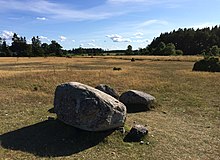Sangelsten
The Sangelsten (also Sangelstain) is a bowl stone from the Bronze Age , which is located on the Lajkarhajd, near Lärbro on the Swedish island of Gotland . 19 small bowls are sunk into its surface.
The Sangelstainen (from singen) or sound stone is a 1.5 m³ large boulder and is regarded as a sacrificial stone . There are many archaeological sites on the Laikarhaid, mainly from the Bronze and Early Iron Ages ( cemetery of Domarlunden ). The area appears to have been an important place around 3000 years ago. The stone produces a sound when struck with metal; thus he is the subject of many legends.
The Gyllenstein on Fole and the bell stone on Fårö are nearby.
Legend
Legend has it that the pits on the Sangelsten were created when the Norwegian King Olaf the Saint defeated the islanders on the Laikarhaid in a battle in 1028. Olof had come to the island to Christianize the Gotlanders by force of arms. The Gotland army was led by the peasant leader Dacka. When Olof saw the large army of farmers, he fell on his knees at the stone and prayed for strength to defeat the Gotlanders. His knees and elbows made the indentations on the stone. But after the Gutasage , Gotland was Christianized in a completely different way and Olaf was never on the island.
Web links
- Description and picture (Swedish)
- image
Coordinates: 57 ° 46 ′ 58.7 " N , 18 ° 48 ′ 45.7" E
